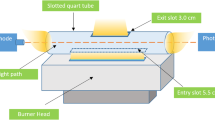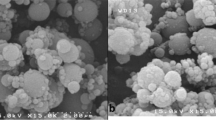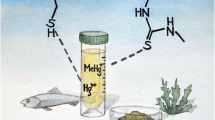Abstract
The acidic reduction of Hg using a continuous-flow analytical system was evaluated. With 25% SnCl2 as the reductant, characteristic concentrations (sensitivities) of 0.44 μg/L (open cell) and 0.29 μg/L (flow-through cell) were obtained using inorganic Hg2+ standards in 1.5% HCl. When CH3Hg+ standards were used, absorption signals were an order of magnitude lower, indicating that Sn(II) is incapable of producing Hg° from organic Hg in this acidic reduction system. Addition of CdCl2 to the SnCl2 reductant, as suggested by Magos (1) for the reduction of organomercurials under alkaline conditions, was without beneficial effect. Similarly, combining Sn, with another reducing agent (hydroxylamine hydrochloride), or a strong alkaline solution (40% NaOH), in the reaction coil of the flow-through system did not significantly enhance the Hg absorption signal for either inorganic or organic Hg. Recovery of Hg from spiked liver homogenates digested at 70–80°C using a HNO3/H2SO4/HCl procedure and stabilized with 0.5 mM K2Cr2O7 was >85%, using either inorganic Hg2+ or CH3Hg+, indicating that this digestion procedure successfully breaks the C-Hg bond to form readily reducible Hg species. Usingl-cysteine to stabilize standards of inorganic Hg2+ in HCl caused significant depressions of the Hg absorption signal atl-cysteine concentrations >0.001% (≈0.5 mM); 0.1%l-cysteine caused total suppression of the Hg signal. These results indicate that: (1) acidic reduction of Hg by Sn in this continuous-flow system requires breakdown of organomercurials prior to analysis; (2) tissue digestion using HNO3/H2SO4/HCl followed by the addition of K2Cr2O7 to stabilize Hg2+ achieves this breakdown and allows good recovery of total Hg; and (3) use ofl-cysteine to complex and prevent losses of Hg should be avoided in systems using acidic reduction of Hg. Concentrations of endogenous tissue sulfhydryls are generally lower than those associated with depressed absorbance signals during the acidic reduction of Hg.
Similar content being viewed by others
References
L. Magos,Analyst 96, 847 (1971).
World Health Organization,Environ. Health Criteria 86, 115 pp. (1989).
R. A. Bodaly, R. E. Hecky, and R. J. P. Fudge,Can. J. Fish. Aquat. Sci. 41, 682 (1984).
T. W. Clarkson,Environ. Toxicol. Chem. 9, 957 (1990).
M. R. Winfrey, and J. W. M. Rudd,Environ. Toxicol. Chem. 9, 853 (1990).
A. M. Ure,Anal. Chim. Acta 76, 1 (1975).
W. R. Hatch and W. L. Ott,Anal. Chem. 40, 2085 (1968).
J. C. Gage and J. M. Warren,Ann. Occup. Hyg. 13, 115 (1970).
L. Magos and T. W. Clarkson,J. Assoc. Anal. Chem. 55 966 (1972).
P. Coyle and T. Hartley,Anal. Chem. 53, 354 (1981).
R. Yamammoto, H. Satoh, T. Suzuki, A. Naganuma, and N. Imura,Anal. Biochem. 101, 254 (1980).
J.-P. Farant, D. Brissette, L. Moncion, L. Bigras, and A. Chartrand,J. Anal. Toxicol. 5, 47 (1981).
D. C. Wigfield, S. M. Croteau, and S. L. Perkins,J. Anal. Toxicol. 5, 52 (1981).
D. C. Wigfield and S. A. Eatock:J. Anal. Toxicol. 11, 137 (1987).
C.-H. Ngim, S.-C. Foo, and W.-O. Phoon,J. Anal. Toxicol. 12, 132 (1988).
L. Magos and A. A. Cernik,Br. J. Indus. Med. 26, 144 (1969).
J. Fawkes, M. Folsom, and E. O. Oswald,Anal. Chim. Acta 82, 55 (1976).
H. W. Louie,Analyst 108, 1313 (1983).
J. L. Burguera and M. Burguera,J. Food Compos. Anal. 1, 159 (1988).
D. Gardner and G. Dal Pont,Anal. Chim. Acta 108, 13 (1979).
T. C. Stuart,Anal. Chem. Acta 96, 83 (1978).
T. C. Rains and O. Menis,J. Assoc. Offic. Anal. Chem. 55, 1339 (1972).
J. Toffaletti and J. Savory,Anal. Chem. 47, 2091 (1975).
C. E. Oda and J. D. Ingle,Anal. Chem. 53, 2305 (1981).
B. T. Sturman,Appl. Spectrosc. 39, 48 (1985).
D. C. Stuart,Anal. Chim. Acta 106, 411 (1979).
S. B. Adeloju and T. F. Mann,Anal. Let. 20, 985 (1987).
S. H. Omang,Anal. Chim. Acta 63, 247 (1973).
R. S. Daniels and D. C. Wigfield,J. Anal. Toxicol 13, 214 (1989).
A. Meister and M. E. Anderson,Annu Rev. Biochem. 52, 711 (1983).
A. Bouchard,At. Absorp. Newsl. 12, 115 (1973).
R. J. Watling,Anal. Chim. Acta 99, 357 (1978).
Author information
Authors and Affiliations
Rights and permissions
About this article
Cite this article
Scheuhammer, A.M., Bond, D. Factors affecting the determination of total mercury in biological samples by continuous-flow cold vapor atomic absorption spectrophotometry. Biol Trace Elem Res 31, 119–129 (1991). https://doi.org/10.1007/BF02990420
Received:
Accepted:
Issue Date:
DOI: https://doi.org/10.1007/BF02990420




